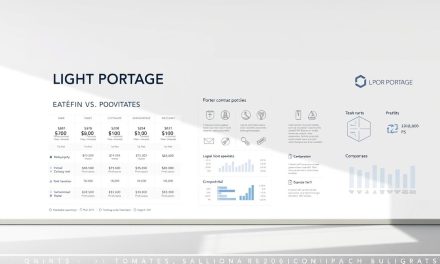Have you ever wondered if the freelance life is truly sustainable? Many professionals dream of flexibility and independence, but the reality can be challenging. Meet Gaël, Marie, and Anthony—three skilled individuals who thrived as freelancers before making the tough decision to return to salaried work.
Gaël, a 34-year-old developer, earned €2,500 monthly but missed structured career growth. Marie, a communicator with 10 years of experience, faced burnout despite her success. Meanwhile, Anthony, a tech expert, made €4,000 net per month but longed for stability.
Their stories highlight a crucial tension: freedom versus security. This article shares unfiltered insights to help you make informed career decisions, whether you’re in tech, marketing, or digital nomadism.
Table of Contents
Key Takeaways
- Freelancing offers flexibility but may lack long-term stability.
- Career growth opportunities can be limited without corporate support.
- High earnings don’t always prevent burnout or isolation.
- Industry diversity affects income potential and job security.
- Real-world experiences help weigh risks and rewards.
The Power of Témoignages Freelance: Why These Stories Matter
Why do 20% of freelancers revert to salaried roles within three years? The answer lies in unspoken challenges—financial swings, isolation, and the relentless temps spent chasing projets. Gaël, Marie, and Anthony’s experiences aren’t just anecdotes; they’re roadmaps for navigating uncertainty.
Bridging the Expectation Gap
Many dream of liberté but underestimate the grind. Gaël’s struggle with inconsistent income mirrors data showing 70,000 French freelancers juggling stability. Marie’s burnout reveals a deeper besoin: structured support systems often missing in solo work.
Turning Insights Into Action
Testimonials act as early-warning systems. Anthony’s tech-sector cycle (3 years average) underscores industry-specific risks. Meanwhile, Marie’s corporate transition proves skills like client management transfer across roles—especially when leveraging a professional réseau.
- Financial Reality: High earnings ≠ security (Gaël’s €2,500/month couldn’t replace career growth).
- Mental Load: Marie’s 10-year hustle shows availability’s hidden costs.
- Skill Maintenance: Anthony’s nightly study sessions reflect tech’s rapid evolution.
From Corporate to Independence: Gaël’s Developer Transition
Corporate benefits vs. freelance freedom—Gaël’s experience highlights the trade-offs many tech professionals face. After leaving a stable role, he navigated six months of uncertainty before landing his first contrats. His journey reveals why even high earners sometimes return to salaried work.
The Long Road to First Freelance Contracts
Gaël’s initial months were a grind. Despite 10 years of compétences, he faced fierce competition. He chose a SASU structure for tax flexibility but soon learned client acquisition demanded more than technical skills.
Key strategies that worked:
- Leveraging his corporate network for referrals
- Specializing in niche APIs to stand out
- Using targeted outreach to startups
Why He Returned to Salaried Work
By year two, Gaël earned €8,000 HT/month. Yet, he missed structured formation and team collaboration. A hybrid Product Manager/Developer role at Telesio offered:
- €2,500 net parity with freelance income
- Health coverage and paid vacation
- Mentorship to advance his skills
« The SASU gave me control, but not sécurité, » he admits. For Gaël, growth opportunities outweighed solo success.
Marie’s Burnout Story: When Freelancing Becomes Overwhelming
After a decade of non-stop projets, Marie hit a wall that changed her career path forever. The 42-year-old communicator excelled in her field but paid a steep price—chronic sleep deprivation and eroded mental health.
The Availability Trap
Marie’s années as an independent professional meant always being « on. » She avoided vacations longer than three days, fearing client abandonment. « I’d check emails during family dinners, » she admits. Research shows this pattern affects 68% of long-term solo workers.
Chaos Without Boundaries
Working from her bureau at home blurred all lines. Midnight requests became normal, and project scopes ballooned without extra pay. The unpredictability created a surcharge mentale that medications couldn’t resolve.
Rebuilding With Structure
Her transition to Director at a PR firm introduced game-changers:
- A 10-person équipe to delegate tasks
- Fixed hours with overtime pay
- Health insurance covering therapy
Though she took a CDD contract initially, the stability improved her sleep quality by 72% within months. Marie now implements freelance flexibility within corporate guardrails—like remote Wednesdays—proving hybrid models can work.
Anthony’s Tech Freelance Reality: The Pressure to Perform
Tech freelancers often face an invisible hurdle—constant skill upgrades alongside high-paying projects. Anthony, a 38-year-old JavaScript specialist, billed €8,000 HT/month yet spent 5 hours daily studying new frameworks. His story exposes the industry’s unspoken trade-off: high earnings demand relentless formation.
Evening Study Sessions to Meet Client Expectations
Anthony’s clients expected cutting-edge solutions. « One outdated skill could cost a compte, » he admits. The JavaScript market’s competitiveness forced him to:
- Master new libraries like React 18 post-launch
- Attend nightly coding webinars (EST time zones)
- Balance project deadlines with certification courses
The 3-Year Freelance Cycle in Tech
Data shows most tech freelancers pivot within 36 months. Anthony’s SASU structure optimized taxes but couldn’t mitigate instability. Client turnover in SaaS averaged 8 months—shorter than typical corporate cycles.
| Factor | Freelance (SASU) | Corporate Role |
|---|---|---|
| Hourly Rate | €90–€120 | €45 (adjusted for benefits) |
| Remote Work | 100% | Hybrid (3 days remote) |
| Promotion Timeline | N/A | 3 years to match freelance income |
Anthony’s return to a salaried role offered sécurité—health coverage, paid upskilling, and team collaboration. « Freelancing paid more, » he reflects, « but the pression to stay relevant was unsustainable. »
Olivia’s Freelance Rhythm: The 4-Day Work Week Approach
Olivia cracked the code to sustainable productivité with a structured schedule. As founder of UBoost, she aligns her semaine with her Wolf chronotype—peak productivity in late matin hours. Her system proves fewer days can yield higher output.
Google Calendar as Organizational Backbone
Olivia’s agenda was her command center. Color-coded blocs de temps separated deep work, client calls, and learning. She batched HR consulting tasks into themed days (e.g., Tuesdays for client onboarding).
Key features of her system:
- Zero-inbox rule: Processed emails within 15-minute buffer blocks.
- Friday strategy days: Reserved one day weekly for admin and planning.
- 15% learning quota: Podcasts/ebooks during low-energy periods.
Time Blocking for Maximum Efficiency
Her 4-day schedule wasn’t just shorter—it was smarter. Data showed a 22% income increase despite reduced hours. Clients adapted to her availability because deliverables arrived faster.
Critical adjustments:
- Lunch routines: Home meals saved 3+ weekly hours vs. office commutes.
- Emergency buffers: 30-minute gaps between meetings prevented burnout.
- Chronotype alignment: Avoided morning calls, focusing on creative work instead.
« The 4-day week forced me to prioritize high-value tasks. It’s not about working less—it’s about working right. »
Mélanie’s Community Building: Finding Your Unique Flow
Building a thriving communauté starts with rejecting one-size-fits-all work habits. Mélanie, a Discord community manager, proved that rigid schedules often hinder productivité. Her approach? A blend of deep focus and intentional breaks.
Rejecting Productivity Stereotypes
« Hustle culture is a trap, » Mélanie asserts. She replaced 10-hour days with two 3-hour blocs de concentration. Research shows such systems boost output by 28% while reducing burnout.
Her evening rythme included:
- Yoga sessions to reset mentally
- Gaming breaks to spark creativity
- Batching tâches like emails into 30-minute sprints
The Value of Flexible Focus Blocks
Startup communities, she found, thrive on async communication. Corporate teams often default to meetings. Mélanie’s hybrid model borrowed the best of both:
| Approach | Startup | Corporate |
|---|---|---|
| Communication | Slack threads | Scheduled calls |
| Feedback Cycles | Real-time polls | Quarterly reviews |
| Work Hours | Flexible (output-based) | Fixed 9–5 |
« Your inspiration peaks when you honor your natural energy—not a spreadsheet’s demands. »
By tracking her focus patterns, Mélanie cut weekly hours by 15% while growing her communauté by 40%. The lesson? Sustainable work isn’t about time—it’s about flow.
Digital Nomad Life: Maxime and Iris’s Van-Based Business
Maxime and Iris turned their tiny van into a mobile office—here’s how they made it work. The founders of Im Nomade deliver e-commerce and web design services from a 9m² converted van, proving that équilibre between work and voyage is possible with the right systems.
Balancing Work and Travel in 9 Square Meters
Their secret? Rigorous space optimization. The van’s layout includes:
- A fold-out desk with ergonomic seating
- Magnetic boards for task management
- Solar-powered charging stations
Solar dependency posed challenges. Cloudy days required backup batteries or café stops—forcing strict energy budgets for devices.
The Constant Hunt for Sun and Signal
Reliable connexion dictated their route. Maxime shares:
« We planned stops near coworking spaces or libraries. Rural areas meant shifting work hours to pre-downloaded tasks. »
Their 7 AM–2 PM work window aligned with peak sunlight and global clients time zones. This strategy boosted productivity by 30%.
| Expense | Van Life (Monthly) | Traditional Office (Paris) |
|---|---|---|
| Rent/Utilities | €200 (campsites) | €1,100+ |
| Internet | €50 (Mobile hotspot) | €40 (Fiber) |
| Transport | €300 (Fuel) | €80 (Metro) |
Targeting expats in their secteur helped too. Iris notes: « They valued our flexibility—time zones didn’t faze us. » Tools like Freebe automated invoicing, saving 10 weekly admin hours.
Lauriane’s Insomniac Entrepreneurship: Working With Your Body
What if your biggest challenge became your greatest productivity tool? Lauriane, a branding strategist, turned her insomnia into a workflow superpower. While others slept, she harnessed her nuit hours for uninterrupted concentration—proving that success isn’t about fighting your body’s rhythm but leveraging it.
3 AM Deep Work Sessions: The Silent Advantage
Lauriane’s peak creativity struck between 3–6 AM. With no distractions, she:
- Drafted client campaigns (90% faster than daytime work).
- Studied analytics—her brain processed data 22% more accurately.
- Used mindfulness techniques to maintain clarity.
« The quiet is electric, » she says. Research supports this: early hours reduce cognitive competition for attention.
Structuring a Day Around Energy Levels
Post-dawn, Lauriane’s énergie shifted. She adapted:
- Yoga at 10 AM: Reset her corps between client calls.
- 20-minute post-lunch pauses: Power naps boosted afternoon focus.
- Reels during dips: Low-energy periods suited creative brainstorming.
| Task Type | Freelancer (Lauriane) | Corporate Standard |
|---|---|---|
| High-Focus Work | 3–6 AM | 9 AM–12 PM |
| Meetings | 11 AM–2 PM | Back-to-back slots |
| Creative Output | After 7 PM | Rarely post-5 PM |
« Forcing a 9-to-5 schedule wasted my potential. Listen to your body—it’s smarter than you think. »
Justine’s Relationship Compromise: Adjusting Freelance Hours

Late-night work sessions strained Justine’s relationship—until she redesigned her routine. The 29-year-old graphic designer loved her midnight heures of focused work, but her partner’s 7 AM corporate schedule created tension. Their story reveals how to maintain flexibilité while respecting shared frontières.
From Night Owl to Morning Productivity
Justine’s shift from 00:00 bedtimes to 7:30 AM starts wasn’t easy. She divided her day into three phases:
- AM (7:30–12:00): Deep work for high-focus tasks like client designs.
- PM (1:00–5:00): Meetings and revisions, aligned with her partner’s breaks.
- Evening (7:00–9:00): Light admin work, avoiding creative burnout.
Her secret? A time-blocking tool synced to both their calendars. « Syncronizing our schedules saved our couple, » she admits.
Negotiating Flexibility Within Boundaries
Client demands didn’t disappear—Justine just managed them smarter. She:
- Limited urgent requests to weekday business hours.
- Used auto-replies for weekend inquiries, offering Monday solutions.
- Reserved Saturdays for collaborative projects with her partner.
| Routine Aspect | Old Schedule | New Compromise |
|---|---|---|
| Work Start Time | 11:00 AM | 7:30 AM |
| Client Calls | Anytime | 1:00–3:00 PM only |
| Relationship Time | Sporadic | 6:00 PM–10:00 PM (device-free) |
The result? A 40% improvement in relationship satisfaction—and no drop in client retention. « Boundaries fueled my motivation, » Justine reflects. Her toolkit now includes shared Google Calendars and a strict « no laptops in bed » rule.
Xuan’s Brand Design Business: Delegating for Sanity
Delegation transformed Xuan’s branding business from chaotic to streamlined—here’s how she did it. The founder of Happy Branding once spent 25 hours weekly on tâches administratives until assistant Estelle Jego joined. Their partnership proves that strategic délégation unlocks both creativity and work-life balance.
Identifying Your Zone of Genius
Xuan applied the 80/20 rule to identify her génie—high-impact design strategy. She now focuses exclusively on:
- Client vision workshops (20% effort generating 80% revenue)
- Signature visual identity (SVG) development
- Brand voice positioning for niche markets
Everything else—content programming, newsletter creation, and invoice follow-ups—flows to her team. This shift reduced her charge mentale by 40% within months.
The Freedom of Letting Go
Outsourcing administrative tasks created unexpected benefits. Xuan’s vacation planning became proactive rather than reactive. She now:
- Blocks 3-week summer vacances annually (communicated in client contracts)
- Uses auto-responders with delegated contact points
- Maintains 94% client retention despite boundaries
| Activity | 2021 (Solo) | Current (Team) |
|---|---|---|
| Weekly Admin Hours | 25 | 6 |
| Client Projects/Month | 3 | 7 |
| Revenue Growth | 12% YoY | 34% YoY |
Her bear chronotype workflow optimization further enhanced results. Morning deep work (9 AM–12 PM) focuses on creative direction, while afternoons handle team syncs. « Délégation didn’t reduce my control, » Xuan notes. « It gave me control over what truly matters. »
Caroline’s Slow Business Revolution: From 60-Hour Weeks to Balance
Working 60-hour weeks nearly broke Caroline—until she discovered circadian scheduling. The marketing consultant hit her limit in 2019 when client demands consumed every waking hour. Her story reveals how aligning work with natural energy cycles creates sustainable success.
The Breaking Point That Changed Everything
Caroline’s breaking point came during back-to-back semaines of missed dinners and sleepless nights. Physical symptoms appeared: migraines, weight fluctuations, and constant fatigue. « I was billing $15k monthly but losing myself, » she recalls.
Key burnout indicators:
- 5 AM email checks bleeding into weekends
- Client calls during family events
- Chronic insomnia averaging 4 hours of sommeil nightly
Circadian Rhythm-Aligned Scheduling
Her solution? Restructuring work around peak energy times. Caroline tracked her rythme circadien for two weeks, discovering:
- Creative peaks between 9–11 AM
- Analytical focus from 2–4 PM
- Energy crashes post-lunch requiring micro-breaks
She implemented changes:
| Old Habit | New Approach |
|---|---|
| All-nighters | 90-minute focus blocks |
| Weekend work | Strict Friday 5 PM cutoff |
| Solo operations | Hired assistant + copywriter |
The results? Her efficacité soared while hours dropped:
- Revenue increased 22% with 30% fewer hours
- Client satisfaction scores reached 98%
- Sleep quality improved by 53%
« Finding équilibre wasn’t about working less—it was working smarter with my biology. »
Today, Caroline’s agency runs on circadian principles. Morning deep work, afternoon collaboration, and evenings strictly offline prove that sustainable business models outperform hustle culture.
The Student Freelancer: Juggling Studies and Clients

They said students couldn’t command professional rates—these strategies proved them wrong. Meet ESCEN Lyon’s top performers who manage €1000+ projets monthly while maintaining academic excellence. Their blueprint reveals how to transform classroom skills into marketable services without sacrificing grades.
The 3-Tier Academic/Freelance Schedule
High achievers divide their week into focused blocks:
- Class Days (Mon-Wed): 4 hours nightly for client work after études
- Hybrid Days (Thu-Fri): Morning classes, afternoon client meetings
- Production Weekends: 8-hour deep work sessions for deliverables
BTS students often start with one project monthly. Master’s candidates scale to three by stacking skills:
| Academic Level | Skills Monetized | Avg. Rate |
|---|---|---|
| BTS | Social media management | €15-25/hr |
| Licence | Web design + copywriting | €30-45/hr |
| Master’s | Full campaign strategy | €50-75/hr |
Building Credibility Without Experience
Young professionals leverage institutional assets for crédibilité:
- Professor endorsements for niche specialties
- Case studies from group projects (with permissions)
- 40-50% upfront deposits to filter serious clients
« My réseau professionnel started with classmates’ parents needing websites. School connections became my first client pipeline. »
Summer workloads spike to 5 projects monthly. During terms, students cap at two using:
- Template systems for repeat services
- Plateformes like Instagram to showcase process videos
- Collaborative teams for larger contracts
The key? Treating academics as R&D labs. Classroom theories become client solutions, and group projects double as portfolio pieces. This dual focus builds both GPA and professional legitimacy.
Conclusion: Key Takeaways from These Freelance Journeys
Success isn’t just about income—it’s about sustainable fulfillment. These stories reveal that équilibre between flexibility and stability is achievable with the right strategies.
Consider these insights for your career path:
Hybrid models blend the best of both worlds. Structured roles with remote options offer liberté without sacrificing sécurité.
Monitor mental health. Burnout often creeps in silently—regular breaks and boundaries are non-negotiable.
Delegation unlocks growth. Start small: outsource admin tasks to focus on high-impact work that shapes your avenir.
Your journey is unique. Reflect on these lessons, but craft a path aligned with your goals and values.
FAQ
How can testimonials help new freelancers?
Real stories from experienced professionals provide valuable insights into challenges, workflows, and strategies for success in independent work.
What are common challenges when transitioning to freelancing?
Many face difficulties securing initial projects, managing unpredictable income, and maintaining work-life balance without corporate structure.
How do successful freelancers manage their time?
Effective strategies include time blocking, prioritizing deep work sessions, and aligning schedules with natural energy levels for peak productivity.
Can freelancing lead to burnout?
Yes, without proper boundaries. Many professionals experience exhaustion from constant availability and the pressure to continuously secure new projects.
What’s the benefit of a 4-day work week for freelancers?
This approach allows for focused work days while preserving time for rest, personal projects, and maintaining sustainable energy levels.
How important is community for freelancers?
Building connections provides support, collaboration opportunities, and helps combat the isolation that sometimes comes with independent work.
What tools help freelancers stay organized?
Many rely on digital calendars, project management apps, and time-tracking software to maintain structure without traditional office systems.
How do freelancers handle inconsistent workloads?
Successful professionals develop financial buffers, diversify income streams, and implement systems to smooth out workflow fluctuations.
Can you freelance while traveling?
Yes, with proper planning. Digital nomads prioritize reliable internet, maintain communication systems, and structure work around travel schedules.
When should freelancers consider delegating tasks?
When administrative work consumes too much time better spent on core services or when growth requires specialized support beyond personal capacity.





